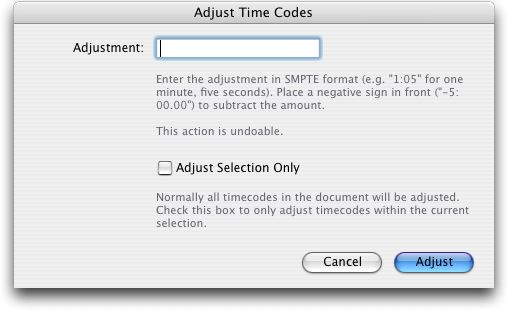3.7 Transcription Tips
Everyone approaches transcription and analysis in their own way, shaped by their research training, goals, and the practices of their community. InqScribe provides a highly flexible transcription environment so that you can adapt InqScribe to how you want to work, instead of the other way around.
This page provides some tips for how to work with transcripts that may help you better integrate InqScribe into your existing work environment.
3.7.1 Adjusting Timecodes
By default, InqScribe assumes the start time for each media object is 00:00.00. However, there may be cases in which you want to adjust the start time. For instance, you may want to think of the start time of your media as 1:00:00 (because you started filming at 1pm) or 35:00 (because you are reviewing a brief clip extracted from a longer tape, and the clip starts 35 minutes into the tape).
InqScribe provides two tools to help you adjust timecodes to reflect this.
First, the Start Time field in the Select Media Source dialog lets you define a non-zero start time for your media object. Once you do this, all timecodes calculated by InqScribe will take this start time into account.
Sometimes, however, you may need to change a bunch of timecodes at once without changing the start time value. You can do this by using the Transcript > Adjust Timecodes... menu item.
By default, this command affects all timecodes within your transcript, but you can check the Adjust Selection Only button to limit the changes to the timecodes within the current selection.
Tip: When InqScribe adjusts timecodes, it also replaces the timecode formatting. So if you decide that you want to change the way all of your timecodes are formatted, you can use the Transcript Settings dialog to change the default formatting style, and then adjust all the timecodes by "0:00" to update the formatting without changing the actual value of any of the timecodes.
3.7.2 Using InqScribe With Other Applications
InqScribe is primarly designed for transcription, annotation, and light analysis work. For more complex analysis work, many researchers turn to other applications, including Excel, nVivo, or a custom database application.
InqScribe provides several export options in order to make it easy to share your work with such applications. To take best advantage of this export capability, however, it's worth thinking about how you might structure your transcript.
Bookmarks vs. Scenes
Remember that InqScribe is based on "timecode as bookmark" model. With this approach, each timecode provides a hyperlink to a specific point in time. As a general convention, the text in the transcript that follows a timecode is assumed to relate to that time, but nothing in InqScribe enforces this presumption. Here's an example.
[2:00.00] This text is associated with whatever happened at the two minute mark.
[3:00.00] Something else happened at three minutes.
In contrast, other analysis applications often work with a "scene-based" model. In this model, individual scenes within a video sequence are formally defined using two timecodes: a start time and an end time.
Scenes can be represented in InqScribe simply by inserting the end time at the end of the paragraph. Here's an example.
[2:00.00] This text is associated with whatever happened at the two minute mark. [3:00.00]
[3:00.00] Something else happened at three minutes. [5:00.00]
When your scenes are contiguous, the end time from one scene and the start time of the next scene are often the same. But this isn't always the case; it's up to you whether you want to enforce this convention.
Preparing to Export Scenes
When InqScribe exports transcripts in tab-delimited or XML format, it automatically breaks your transcript up into scenes based on where your timecodes appear. Each inferred "scene" starts with one of your timecodes, and the annotation for that scenes consists of the all the text that follows that timecode.
If you are planning to export to tab-delimited format, be aware that any tabs within your text will be converted to spaces, and any line breaks will be converted to vertical tabs (ASCII 11).
Removing Timecodes
Sometimes, you want to copy and paste your transcript into some other application without the timecodes getting in the way. You can use the exporting options to export a text file with the timecodes removed, and then import that file in the other application.
3.7.3 Working With Locked Files
If you open a locked file in InqScribe, the transcript is opened in read-only mode. This means you can read the transcript and copy text from the transcript, but you cannot change it. (Clicking on timecodes to jump to that point in the media still works.)
You can change the media file used with the transcript (via the Select Media Source dialog), but this change will be temporary -- you cannot save the change.
If you want to edit the locked file, either make a copy of the file (File > Save As... will work for this) or unlock the file using Explorer (Windows) or the Finder (Mac OS).

